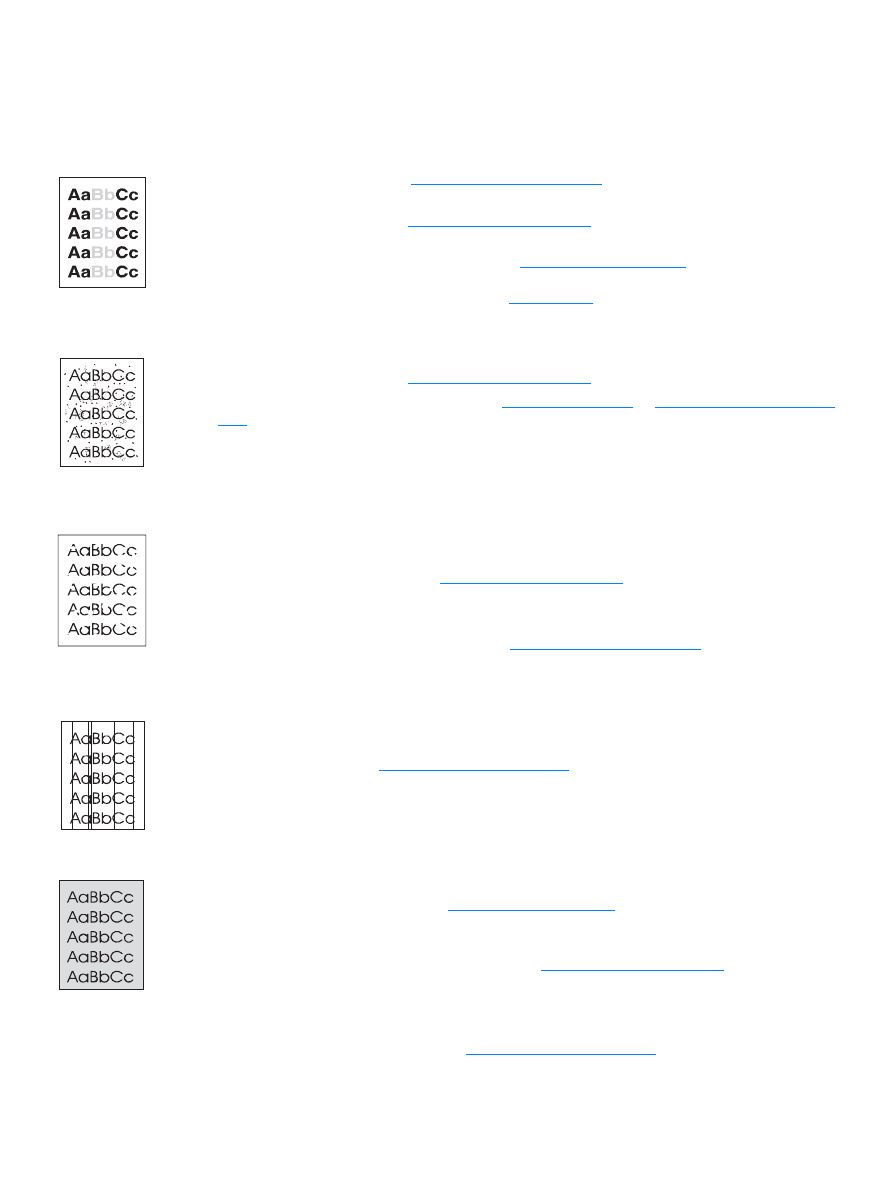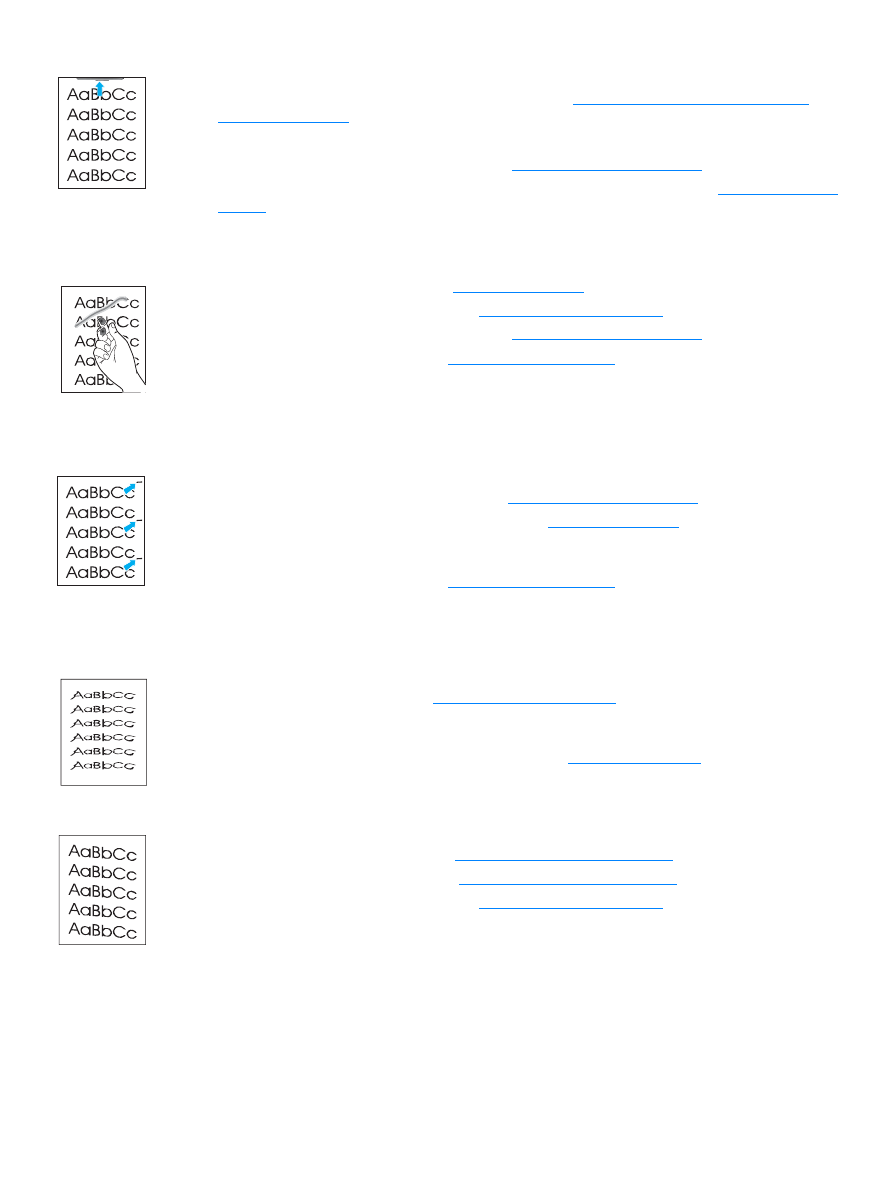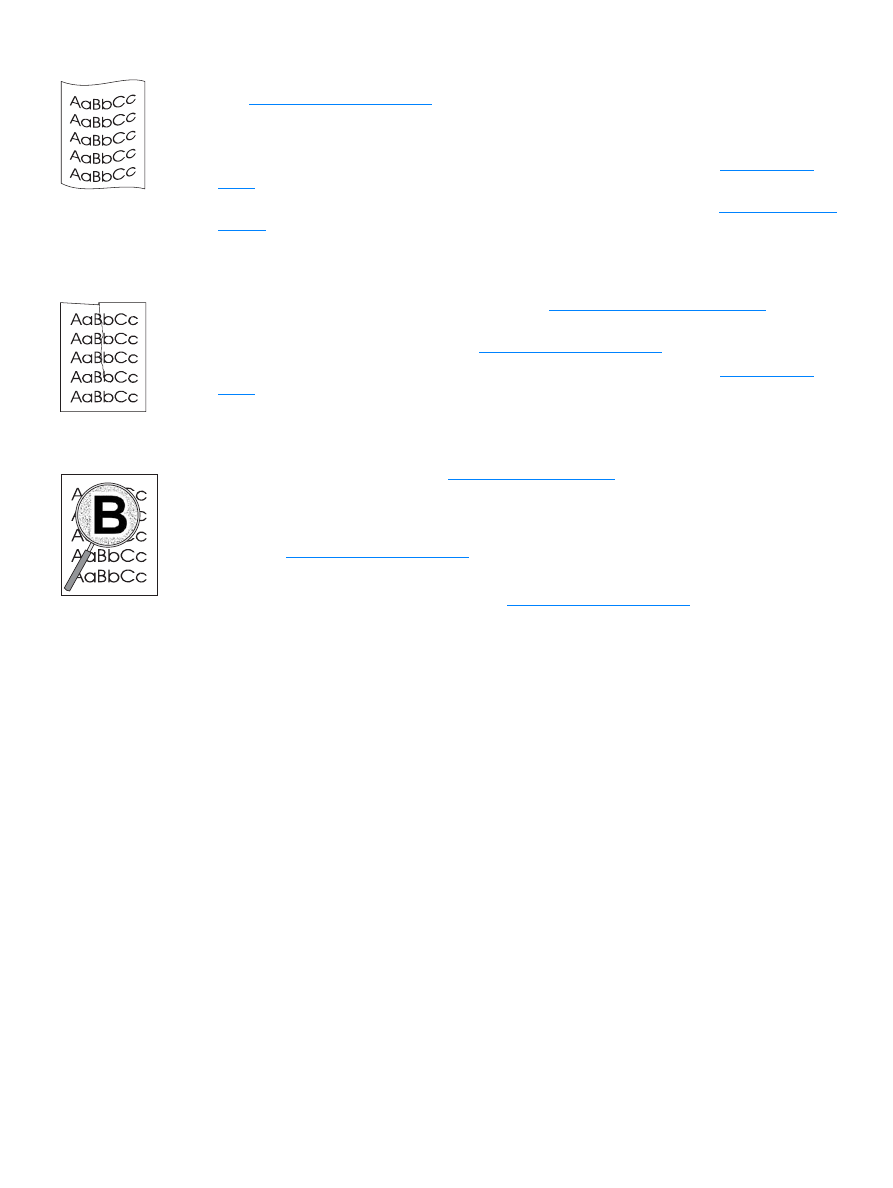
Improving print quality
This section provides information about identifying and correcting print defects.
Light print or fade
●
The toner supply is low. See
Managing the toner cartridge
for more information.
●
The media might not meet Hewlett-Packard’s media specifications (for example, the media is
too moist or too rough). See
Printer media specifications
for more information.
●
If the whole page is light, the print density adjustment is too light or EconoMode might be
turned on. Access the printer properties. See
Printer properties (driver)
for instructions. Click
the
Configure
tab, and adjust the
Print Density
setting. Click the
Finishing
tab, and clear the
EconoMode (Save Toner)
check box. See
Saving toner
for more information.
Toner specks
●
The media might not meet Hewlett-Packard’s media specifications (for example, the media is
too moist or too rough). See
Printer media specifications
for more information.
●
The printer might need to be cleaned. See
Cleaning the printer
or
Cleaning the printer media
path
for instructions.
Dropouts
●
A single sheet of media might be defective. Try reprinting the job.
●
The media’s moisture content is uneven or the media has moist spots on its surface.
Try printing with new media. See
Printer media specifications
for more information.
●
The media lot is bad. The manufacturing processes can cause some areas to reject toner.
Try a different type or brand of media.
●
The toner cartridge might be defective. See
Managing the toner cartridge
for more
information.
Vertical lines
●
Make sure that the input tray cover is in place.
●
The photosensitive drum inside the toner cartridge has probably been scratched. Install a new
HP toner cartridge. See
Changing the toner cartridge
for instructions.
Gray background
●
Make sure that the input tray cover is in place.
●
Access the printer properties. See
Printer properties (driver)
for instructions. Click the
Configure
tab, and decrease the
Print Density
setting. This decreases the amount of
background shading.
●
Change the media to a lighter basis weight. See
Printer media specifications
for more
information.
●
Check the printer’s environment. Very dry (low humidity) conditions can increase the amount
of background shading.
●
Install a new HP toner cartridge. See
Changing the toner cartridge
for instructions.

46 Chapter 6 Troubleshooting the printer
ENWW
Toner smear
●
If toner smears appear on the leading edge of the media, the media guides might be dirty.
Wipe the media guides with a dry, lint-free cloth. See
Identifying the printer’s components
or
Cleaning the printer
for more information.
●
Check the media type and quality.
●
Try installing a new HP toner cartridge. See
Changing the toner cartridge
for instructions.
●
The fuser temperature might be too low. Access the printer properties. See
Printer properties
(driver)
for instructions. Click the
Paper
tab, and make sure that you have selected the
appropriate media from the
Optimize for
drop-down list.
Loose toner
●
Clean the inside of the printer. See
Cleaning the printer
for instructions.
●
Check the media type and quality. See
Printer media specifications
for more information.
●
Try installing a new HP toner cartridge. See
Changing the toner cartridge
for instructions.
●
Access the printer properties. See
Printer properties (driver)
for instructions. Click the
Paper
tab, and make sure that you have selected the appropriate media from the
Optimize for
drop-down list.
●
Plug the printer directly into an AC outlet instead of into a power strip.
Vertical repetitive defects
●
The toner cartridge might be damaged. If a repetitive mark occurs at the same spot on the
page, install a new HP toner cartridge. See
Changing the toner cartridge
for instructions.
●
The internal parts might have toner on them. See
Cleaning the printer
for more information.
If the defects occur on the back of the page, the problem will probably correct itself after a few
more printed pages.
●
Access the printer properties. See
Printer properties (driver)
for instructions. Click the
Paper
tab, and make sure that you have selected the appropriate media from the
Optimize for
drop-down list.
Improperly formed characters
●
If characters are improperly formed, producing hollow images, the media stock might be too
slick. Try a different media. See
Printer media specifications
for more information.
●
If characters are improperly formed, producing a wavy effect, the printer might need service.
Print the Windows test page. If the characters are improperly formed, contact an
HP-authorized dealer or service representative. See
Service and support
for more
information.
Page skew
●
Make sure that the media is loaded correctly and the media guides are not too tight or too
loose against the media stack. See
Loading media into the input tray
for more information.
●
The input tray might be too full. See
Loading media into the input tray
for more information.
●
Check the media type and quality. See
Printer media specifications
for more information.

ENWW
Improving print quality 47
Curl or wave
●
Check the media type and quality. Both high temperature and humidity cause media to curl.
See
Printer media specifications
for more information.
●
The media might have been in the input tray too long. Turn over the stack of media in the tray.
Also, try rotating the media 180° in the input tray.
●
Open the straight-through output door and try printing straight through. See
Printer output
paths
for more information.
●
The fuser temperature might be too high. Access the printer properties. See
Printer properties
(driver)
for instructions. Click the
Paper
tab, and make sure that you have selected the
appropriate media from the
Optimize for
drop-down list.
Wrinkles or creases
●
Make sure that the media is loaded properly. See
Loading media into the input tray
for more
information.
●
Check the media type and quality. See
Printer media specifications
for more information.
●
Open the straight-through output door and try printing straight through. See
Printer output
paths
for more information.
●
Turn over the stack of media in the tray. Also, try rotating the media 180° in the input tray.
Toner scatter outline
●
Access the printer properties. See
Printer properties (driver)
for instructions. Click the
Configure
tab, and select
On
in
Transfer Setting
.
●
If large amounts of toner have scattered around the characters, the media might be resisting
the toner. (A small amount of toner scatter is normal for laser printing.) Try a different media
type. See
Printer media specifications
for more information.
●
Turn over the stack of media in the tray.
●
Use media designed for laser printers. See
Printer media specifications
for more information.

48 Chapter 6 Troubleshooting the printer
ENWW